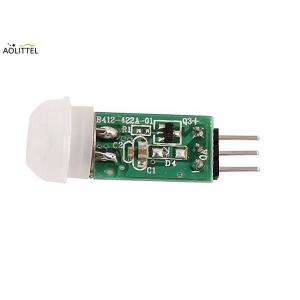
Add to Cart
3m-5m Miniature Controller PIR Dectector Module Passive Infrared Motion Sensor SB412 With Fresnel lens PCB Resistor
Main Parameters
| Type: | SB412 |
| Size: | 18*10mm |
| Supply Current: | DC3V~12V |
| Current Drain: | <20μA |
| Voltage Output: | High level signal:3.0V Stanby output is 0V |
| Delay Time: | Delay time adjustable |
| Operation Temperaute: | -20℃~60℃ |
| Infrared Sensor: | Dual element,Low noise, High Sensitivity |
| Light Sensor: | No CdS |
| TTL Output: | TTL Output can be directly connected to micro-controller or logic device |
| Sensitivity: | High Sensitivity |
General
SB412A is the latest digital sensor module that based on AM412 digital sensor. It only contain a
fresnel lens, PCB, and a few resistance
______________________________________________________________________________ Download________
Download________
Lens Information
Lens diameter: 13.6mm (default), detecting angle≤100°, detecting range<5M.

Compact Size

Schematic Diagram

Application Note

Funtions:
1. DC-INPUT: working voltage or input supply voltage (range is DC 3V-12V)
2. VOUT: signal output pin. Output: High level signal 3V; Standby 0V
VOutput can be as same as DC-Input by adding some components
3. Delay time adjustment: the default delay time is 10s, can be adjusted by changing resistor(see following delay time adjustment form)
Delay Time Adjustment

'''What is a PIR sensor?'''
PIR sensors allow you to sense motion, almost always used to detect whether a human has moved in or out of the sensors range. They are small, inexpensive, low-power, easy to use and don't wear out. For that reason they are commonly found in appliances and gadgets used in homes or businesses. They are often referred to as PIR, "Passive Infrared", "Pyroelectric", or "IR motion" sensors.
PIRs are basically made of a pyroelectric sensor (which you can see above as the round metal can with a rectangular crystal in the center), which can detect levels of infrared radiation. Everything emits some low level radiation, and the hotter something is, the more radiation is emitted. The sensor in a motion detector is actually split in two halves. The reason for that is that we are looking to detect motion (change) not average IR levels. The two halves are wired up so that they cancel each other out. If one half sees more or less IR radiation than the other, the output will swing high or low.
Along with the pyroelectic sensor is a bunch of supporting circuitry, resistors and capacitors. It seems that most small hobbyist sensors use the BISS0001 ("Micro Power PIR Motion Detector IC"), undoubtedly a very inexpensive chip. This chip takes the output of the sensor and does some minor processing on it to emit a digital output pulse from the analog sensor.
For many basic projects or products that need to detect when a person has left or entered the area, or has approached, PIR sensors are great. They are low power and low cost, pretty rugged, have a wide lens range, and are easy to interface with. Note that PIRs won't tell you how many people are around or how close they are to the sensor, the lens is often fixed to a certain sweep and distance (although it can be hacked somewhere) and they are also sometimes set off by house pets. Experimentation is key!